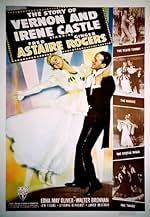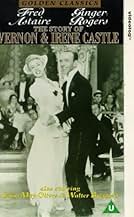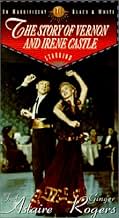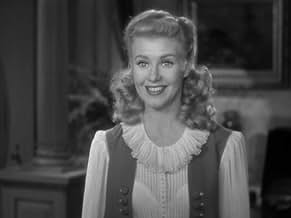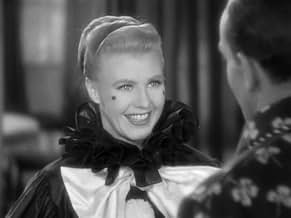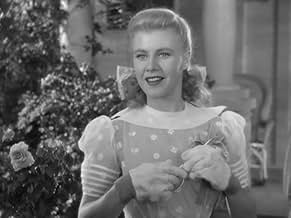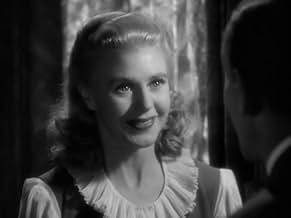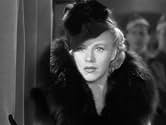A História de Irene e Vernon Castle
Título original: The Story of Vernon and Irene Castle
AVALIAÇÃO DA IMDb
6,9/10
2,9 mil
SUA AVALIAÇÃO
Adicionar um enredo no seu idiomaThe story of the dancing team who taught the world to two-step.The story of the dancing team who taught the world to two-step.The story of the dancing team who taught the world to two-step.
- Direção
- Roteiristas
- Artistas
- Prêmios
- 4 vitórias e 1 indicação no total
Buzz Barton
- Undetermined Secondary Role
- (não creditado)
Max Barwyn
- Waiter - Cafe de Paris
- (não creditado)
Avaliações em destaque
There is one hilarious goof in this delightful film. When Irene and Vernon are having dinner in the Parisian restaurant in which they are to make their debut Irene is wearing her wedding dress as they are too broke to afford to buy her a new evening dress, She is also wearing a little lacy winged hat of the type worn in the national costume of Holland.
In England there were gales of laughter when Irene says "I feel just like a bride again in my wedding dress and my little Dutch cap." In the UK a Dutch cap is a female contraceptive device which I believe is called a "diaphragm" in USA.
In England there were gales of laughter when Irene says "I feel just like a bride again in my wedding dress and my little Dutch cap." In the UK a Dutch cap is a female contraceptive device which I believe is called a "diaphragm" in USA.
This was the last of the Astaire and Rogers films at RKO (they would reunite at MGM for "The Barkeleys of Broadway" [1949]), and represents the studio attempting to find a new way to make the duo popular. It's hard to believe, since the pair have become legends in Hollywood musical history, but by the end of the 1930s audience interest in Astaire and Rogers seemed to be ebbing. Consequently, this film feels *very* different than the rest of their films.
This is not a story of boy meets girl/boy dances with girl/boy loses girl/boy chases and chases girl/boy gets girl and dances with her again. There aren't a ton of the whimsical oddball comic supporting players. And--steady yourself--there are very few full-out major musical numbers. There is no stunning score of songs by Irving Berlin or the Gershwins.
This is because this is a musical biography about the Astaire and Rogers of the previous generation. Hence, the duo are asked not to dance in the manner that made them popular but in the manner that made *the Castles* popular, and to music that *that* couple danced to. Often, when the two dance, we are interrupted by various plot points (ie., cutting to other characters talking instead of keeping the camera on the dancers). One of the few moments where we are able to enjoy them completely is a montage sequence showing the Castles becoming the toast of the nation (with Astaire and Rogers literally dancing across a giant map of the U.S.)
The other major musical number is a solo: Ginger Rogers singing "The Yama Yama Man." Astaire was about to end his contract at RKO, but Rogers still was under contract--so the studio is plainly more interested in trying to build up Rogers for a solo career, and the film indicates this (Rogers' solo, the emphasis on her clothes and hair, etc.) Meanwhile, the film also indicates a growing awareness of the coming war, by dealing with Vernon Castle's enlistment during World War I--one of the first times Astaire had donned a uniform for the cameras (something he would do a *lot* in musicals for the next 5 years).
All in all, it's not what one usually expects from an Astaire and Rogers film, and thus suffers in comparison to "Top Hat" or "Shall We Dance," but still retains a charm and personality nonetheless.
This is not a story of boy meets girl/boy dances with girl/boy loses girl/boy chases and chases girl/boy gets girl and dances with her again. There aren't a ton of the whimsical oddball comic supporting players. And--steady yourself--there are very few full-out major musical numbers. There is no stunning score of songs by Irving Berlin or the Gershwins.
This is because this is a musical biography about the Astaire and Rogers of the previous generation. Hence, the duo are asked not to dance in the manner that made them popular but in the manner that made *the Castles* popular, and to music that *that* couple danced to. Often, when the two dance, we are interrupted by various plot points (ie., cutting to other characters talking instead of keeping the camera on the dancers). One of the few moments where we are able to enjoy them completely is a montage sequence showing the Castles becoming the toast of the nation (with Astaire and Rogers literally dancing across a giant map of the U.S.)
The other major musical number is a solo: Ginger Rogers singing "The Yama Yama Man." Astaire was about to end his contract at RKO, but Rogers still was under contract--so the studio is plainly more interested in trying to build up Rogers for a solo career, and the film indicates this (Rogers' solo, the emphasis on her clothes and hair, etc.) Meanwhile, the film also indicates a growing awareness of the coming war, by dealing with Vernon Castle's enlistment during World War I--one of the first times Astaire had donned a uniform for the cameras (something he would do a *lot* in musicals for the next 5 years).
All in all, it's not what one usually expects from an Astaire and Rogers film, and thus suffers in comparison to "Top Hat" or "Shall We Dance," but still retains a charm and personality nonetheless.
Here's one of those rare films that I like where there are no villains, just a nice, old-fashioned story with good people.
Of all the Fred Astaire-Ginger Rogers films, I would guess this gets the least amount of publicity and if that's true, it's a shame.
There are plenty of dance scenes in here. I prefer the tap dancing to ballroom, but that's just my personal tastes. The famous dancing duo are great with any style. I like Walter Brennan, so it's nice to see him in this film and it also was nice to see Edna May Oliver play a nice character, for a change.
The only complaint was the ending was so predictable. You see it coming a mile away. How true this story is, I can't say, but overall it's one of my favorite Astaire-Rogers movies. I am sorry it gets so little attention.
Of all the Fred Astaire-Ginger Rogers films, I would guess this gets the least amount of publicity and if that's true, it's a shame.
There are plenty of dance scenes in here. I prefer the tap dancing to ballroom, but that's just my personal tastes. The famous dancing duo are great with any style. I like Walter Brennan, so it's nice to see him in this film and it also was nice to see Edna May Oliver play a nice character, for a change.
The only complaint was the ending was so predictable. You see it coming a mile away. How true this story is, I can't say, but overall it's one of my favorite Astaire-Rogers movies. I am sorry it gets so little attention.
This bio-pic about the hugely successful dance team, Vernon and Irene Castle, starts at the time of their meeting and covers the entire breadth of their career, starting just before the advent of WWI. This film was released in 1939, so film audiences had plenty of choices and the competition was strong. Still, this ninth pairing of Fred Astaire and Ginger Rogers experienced modest success.
Irene Castle herself was a technical adviser and helped design the gowns that Ginger wore--which, by the way, are very nice, despite Ginger's protestations.
Because this film covers many years and many happenings, it uses montage quite heavily--something that is usually distracting, but in this case it works well.
The dancing documents a variety of styles, some of which were introduced by Vernon and Irene. At the height of their career, they were trendsetters in dance, fashion, culture and taste. Their first dance in the film is an adaptation of minstrel dancing; later dances include the tango and foxtrot. Astaire must have been familiar with all of these styles and probably had used them in his choreography with sister Adele. Still, his choreography in the film is inspired--showing us the essence of each stage in dance evolution.
Ginger is beautiful and she seems to have a freedom in her performance, as if their relationship had advanced to the point of total trust. I only wish this film--and a few of their others--had been shot in color.
Irene Castle herself was a technical adviser and helped design the gowns that Ginger wore--which, by the way, are very nice, despite Ginger's protestations.
Because this film covers many years and many happenings, it uses montage quite heavily--something that is usually distracting, but in this case it works well.
The dancing documents a variety of styles, some of which were introduced by Vernon and Irene. At the height of their career, they were trendsetters in dance, fashion, culture and taste. Their first dance in the film is an adaptation of minstrel dancing; later dances include the tango and foxtrot. Astaire must have been familiar with all of these styles and probably had used them in his choreography with sister Adele. Still, his choreography in the film is inspired--showing us the essence of each stage in dance evolution.
Ginger is beautiful and she seems to have a freedom in her performance, as if their relationship had advanced to the point of total trust. I only wish this film--and a few of their others--had been shot in color.
The great irony here is that today, if the professional dancing team of Vernon and Irene Castle is remembered at all, it is because Fred Astaire and Ginger Rogers played them in a movie. Plus,many people don't like "The Story of Vernon and Irene Castle", and just find it lacking something. This is probably because there is virtually no romantic conflict between the two in this film. Astaire & Rogers spend practically the entire film either allied or happily married. Because the two are happily married in the film, you're missing all of the fun of the misunderstandings, squabbling, and sexual tension of their other RKO starring vehicles. The conflict is first economic and professional as the pair struggled to get recognized as great dancers, and then there is World War I in which Vernon Castle, as an English native, feels compelled to enlist. The film is quite good, but it is very sentimental and atypical of Astaire & Rogers' other films. This was intended to be the pair's last film together, and was their last film together at RKO. It was just a series of accidental recasting decisions that led them to reunite in "The Barkleys of Broadway" at MGM ten years later, which was a big splash musical in the big splashy MGM tradition, quite different from their earlier films together.
Você sabia?
- CuriosidadesIrene Castle served as a technical advisor on the film. According to Ginger Rogers, Castle disliked every costume she wore and deemed them anachronistic. Due to censorship restrictions, Rogers' costumes evoked late 1930s fashions rather than the more daring styles of Castle's 1910s era. After Rogers refused to bob her hair to portray the hairstyle that Irene had popularized, Castle became more displeased. The studio silenced Castle's protests with an additional payment of $5,000.
- Erros de gravaçãoThe film erroneously depicts the Castles touring with white orchestras. In actuality, Vernon and Irene Castle always toured with a black orchestra; specifically, James Reese Europe's Society Orchestra.
- Citações
Irene Castle: I thought you could be a first dancer, a very beautiful first dancer because you are a beautiful dancer but you're so smug and conceited that you can't see any further than your funny nose!
- ConexõesFeatured in Fred Astaire: Puttin' on His Top Hat (1980)
- Trilhas sonorasOnly When You're in My Arms
(1939)
by Con Conrad - Herman Ruby Bert Kalmar
Sung by Fred Astaire (uncredited)
End dance: Fred Astaire (uncredited) and Ginger Rogers (uncredited)
Principais escolhas
Faça login para avaliar e ver a lista de recomendações personalizadas
- How long is The Story of Vernon and Irene Castle?Fornecido pela Alexa
Detalhes
- Data de lançamento
- País de origem
- Idioma
- Também conhecido como
- A Vida de Vernon e Irene Castle
- Locações de filme
- Empresa de produção
- Consulte mais créditos da empresa na IMDbPro
Bilheteria
- Orçamento
- US$ 1.196.000 (estimativa)
- Tempo de duração
- 1 h 33 min(93 min)
- Cor
- Proporção
- 1.37 : 1
Contribua para esta página
Sugerir uma alteração ou adicionar conteúdo ausente

